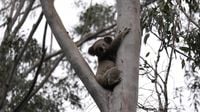In a controversial move, the Victorian government has begun euthanizing koalas from helicopters in Budj Bim National Park, marking a first for Australia. This decision has sparked outrage among animal welfare advocates, with reports indicating that between 600 and 700 koalas have already been shot since March 14, 2025, following devastating bushfires that burned 2,200 hectares of habitat.
The Department of Energy, Environment and Climate (DEECA) has authorized this drastic measure, claiming it is necessary for humane reasons given the injuries and food shortages faced by the koalas after the fires. However, many experts and local residents are questioning the efficacy and ethics of using aerial shooting as a method of wildlife management.
“There is no way they can tell if a koala is in poor condition from a helicopter,” stated Jess Robertson, president of the Koala Alliance, expressing the community’s horror at the plan. This sentiment was echoed by Evan Quartermain, head of programs at Humane World for Animals Australia, who characterized the government's approach as “heavy-handed.”
Quartermain, who has firsthand experience with wildlife rescue efforts from the Black Summer bushfires, emphasized the need for more humane and informed decision-making processes. “Difficult welfare decisions are unavoidable following bushfires, and minimizing animal suffering is often the best outcome that can be hoped for. However, the large-scale and broad justification for intervention at Budj Bim raises serious concerns,” he said.
The ongoing aerial culling has deeply unsettled local communities who cherish the presence of koalas in the area. The constant sound of helicopters flying over Budj Bim has disrupted the peace, and residents are left to grapple with the grim reality that more koalas are targeted for shooting in the coming days.
While DEECA maintains that the aerial shooting is conducted under strict guidelines and involves veterinary oversight, many wildlife advocates are calling for greater transparency and oversight of the program. They argue that the lack of prior public notification about the culling raises significant ethical questions.
As the culling continues, experts are urging the government to halt the logging of healthy eucalyptus trees in private plantations bordering the national park. These trees represent a crucial food source for the surviving koalas, and ongoing logging could exacerbate the already dire situation. “We encourage the department to consider the months ahead for the survivors,” said Glenys Oogjes, CEO of Animals Australia, who described the situation at Budj Bim as “tragic.”
Oogjes has called for an independent review of management plans designed to protect koalas in private timber plantations and for harvesting to be paused until more is known about the movement and impacts on local koala populations.
Concerns are particularly high regarding the welfare of joeys left orphaned when their mothers are shot. One shelter operator noted, “It’s that time of year again when all the females have pouch joeys. Some can survive for several days, but once the mother’s body has gone cold, the young ones will die. It’s a terrible slow death for them.”
Wildlife experts are also linking the increased koala population in Budj Bim to the harvesting of timber plantations that surround the park. As these habitats are destroyed, koalas are forced to migrate into the already densely populated national park, creating unsustainable population densities. “The blue gum plantation owners really need to stand up and take responsibility,” one expert stated, highlighting the negative impact of logging on koala habitats.
Calls for an independent review of the culling program are growing louder, with advocates insisting that the current system is broken. The aerial shooting of koalas is unprecedented in Australia, and the ethical implications of such a method are being scrutinized closely.
In summary, the Victorian government’s decision to cull koalas via aerial shooting has ignited a fierce debate about wildlife management practices in Australia. As animal welfare advocates push for more humane alternatives and greater oversight, the fate of the koalas in Budj Bim National Park hangs in the balance. The ongoing crisis highlights the urgent need for responsible environmental stewardship and the protection of vulnerable wildlife populations.







